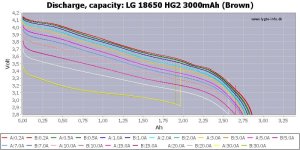eMark
100 kW
For the sake of this comparison we'll use a 12S6P (w/smart BMS) pack of LG HG2 3000mAh cells rated at 20A maximum continuous discharge, and a Charger quite capable of charging at a 6A rate without breaking into a sweat :thumb:
The HG2 Data Sheet ... https://www.18650batterystore.com/v/files/lg_hg2_data_sheet.pdf
Standard Charge ... 1.5A
Fast Charge ... 4.0
Max Charge ... 4.20 +|- 0.05v
Standard Discharge ... 0.6A (what i don't get is why it wouldn't be at least 1.5A, if not 3A)
Fast Discharge ... 10A
Max Continuous Discharge ... 20A
Question: What is it about a lithium cell chemistry (whether Lilo or Lipo) that you dare not charge a pack with the same energy that it's OK to discharge a pack? For example if discharging a 12S6P HG2 pack at a "Fast Discharge" of 10A, why not a "Fast Charge" at 10A (or 5A) instead of a max charge rate of only 4.25A ?
This was debated years ago in RC Lipo forums with the conclusion that you can actually charge at a higher rate than recommended, but it does shorten the cycle life. Well, if that's true than why would anyone want to discharge at 20A if you dare not charge higher than 4.25A with HG2 pack ?
So, any guesses as to the decreased number, if any, of useful charge/discharge cycles between these three 12S6P HG2 battery packs ...
A. Charged at 1.5A and Continuous Discharge at 15A (est. useful charge/discharge cycles?)
B. Charged at 4.0A and Continuous Discharge at 15A (est. useful charge/discharge cycles?)
C. Charged at 6.0A and Continuous Discharge at 15A (est. useful charge/discharge cycles?)
What i'm getting at is why 18650 lithium cells Should NOT Be charged at more than 1.33C, but can be discharged at 6.66C ? So in C. above why can't the pack be charged at 6A when it's OK to discharge it continuously at 20A ? OR another way of comparison is charging the pack at 6A and only discharging at 6A with the useful cycle life outliving both A. and B.
I'm in NO WAY suggesting that it's AOK to start charging at a higher rate than recommended. What i'm inquiring is why it's never OK to charge at the same rate that it is OK to continuously discharge at ? Is it basically because most charging is always done indoors (even though the chance of a fire is no greater than when discharging a pack). Shouldn't need a more expensive BMS when it's already oversized to handle continuous discharge of 20A.
The HG2 Data Sheet ... https://www.18650batterystore.com/v/files/lg_hg2_data_sheet.pdf
Standard Charge ... 1.5A
Fast Charge ... 4.0
Max Charge ... 4.20 +|- 0.05v
Standard Discharge ... 0.6A (what i don't get is why it wouldn't be at least 1.5A, if not 3A)
Fast Discharge ... 10A
Max Continuous Discharge ... 20A
Question: What is it about a lithium cell chemistry (whether Lilo or Lipo) that you dare not charge a pack with the same energy that it's OK to discharge a pack? For example if discharging a 12S6P HG2 pack at a "Fast Discharge" of 10A, why not a "Fast Charge" at 10A (or 5A) instead of a max charge rate of only 4.25A ?
This was debated years ago in RC Lipo forums with the conclusion that you can actually charge at a higher rate than recommended, but it does shorten the cycle life. Well, if that's true than why would anyone want to discharge at 20A if you dare not charge higher than 4.25A with HG2 pack ?
So, any guesses as to the decreased number, if any, of useful charge/discharge cycles between these three 12S6P HG2 battery packs ...
A. Charged at 1.5A and Continuous Discharge at 15A (est. useful charge/discharge cycles?)
B. Charged at 4.0A and Continuous Discharge at 15A (est. useful charge/discharge cycles?)
C. Charged at 6.0A and Continuous Discharge at 15A (est. useful charge/discharge cycles?)
What i'm getting at is why 18650 lithium cells Should NOT Be charged at more than 1.33C, but can be discharged at 6.66C ? So in C. above why can't the pack be charged at 6A when it's OK to discharge it continuously at 20A ? OR another way of comparison is charging the pack at 6A and only discharging at 6A with the useful cycle life outliving both A. and B.
I'm in NO WAY suggesting that it's AOK to start charging at a higher rate than recommended. What i'm inquiring is why it's never OK to charge at the same rate that it is OK to continuously discharge at ? Is it basically because most charging is always done indoors (even though the chance of a fire is no greater than when discharging a pack). Shouldn't need a more expensive BMS when it's already oversized to handle continuous discharge of 20A.


